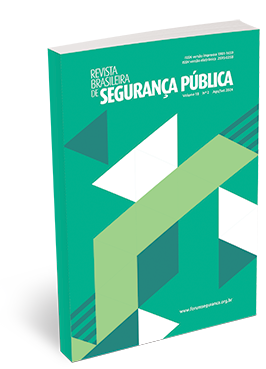Associations Between Prison Recidivism and Working and Educational Experiences During Deprivation of Liberty
DOI:
https://doi.org/10.31060/rbsp.2024.v18.n2.1880Keywords:
Recidivism, Rehabilitation, Santa Catarina, Propensity Score Matching, Frailty ModelAbstract
This essay investigates the impact of inmates’ work and educational programs on recidivism rates over nearly five years for prisoners released from Santa Catarina prisons. Three methods were used to analyze recidivism and to control for self-selection bias and non-observable heterogeneity: propensity score matching, Cox, and frailty models. The frailty model showed that participation in work and educational programs reduced the odds of recidivism by 14% and 32%, respectively. This study suggests that programs are being carried out in Santa Catarina that may effectively impact prisoners’ rehabilitation.
Downloads
References
ADORNO, Sergio; BORDINI, Eliana. Reincidência e Reincidentes Penitenciários em São Paulo (1974 – 1985). Revista Brasileira de Ciências Sociais, 3, 9, 1989, 70-94.
ADORNO, Sergio; BORDINI, Eliana. A Prisão sob a ótica de seus protagonistas: Itinerário de uma pesquisa. Revista de Sociologia da USP: Tempo Social – São Paulo, 1991, 7 - 40. DOI: https://doi.org/10.1590/ts.v3i1/2.84813
ANDERSEN, Signe; ANDERSEN, Lars and SKOV, Pier. Effect of Marriage and Spousal Criminality on Recidivism. Journal of Marriage and Family, 77, 2, 2015, 496-509. DOI: https://doi.org/10.1111/jomf.12176
AOS, Steve; MILLER, Marna; DRAKE, Elisabeth. Evidence-Based Public Policy Options to Reduce Future Prison Construction, Criminal Justice Costs, and Crime Rates. Victims and Offenders, 4, 2009, 170-196. DOI: https://doi.org/10.1080/15564880802612615
BECKER, Howard. Outsiders. Estudos de sociologia do desvio. Rio de Janeiro: Zahar, 2008.
BAEZA, Francisca and GRAU, Nicólas. The Impact of Prison Labor Programs on Recidivism: The Case of Chile. Working Paper, 440, University of Chile, Chile, 2017.
BAQUEIRO, Fernanda. Execução Penal e o Mito da Ressocialização: Disfunções da Pena Privativa de Liberdade. Curitiba: Juruá, 2017.
BITENCOURT, Cezar. A falência da pena de prisão: causas e alternativas. São Paulo: Saraiva, 2017.
BOWLES, Roger; FLORACKIS, Chrisostomos. Duration of the time to reconviction: Evidence from UK prisoner discharge data. Journal of Criminal Justice, 35, 4, 2007, 365-378. DOI: https://doi.org/10.1016/j.jcrimjus.2007.05.002
BRANT Vinicius. O trabalho encarcerado. Rio de Janeiro: Forense, 1994.
BRASIL. Lei (Federal) 7.210, de 11 de julho. Lei de Execuções Penais, 1984.
BRASIL. Diagnóstico do sistema prisional brasileiro. Ministério da Justiça e Segurança Pública, 2018.
CARVALHO, José. Essays on the Microeconometrics of Labor Markets and Criminal Behavior. Ph.D. Thesis - Pennsylvania State University, USA, 2002.
COELHO, Edmundo. Oficina do Diabo e outros escritos sobre criminalidade. Rio de Janeiro: Record, 2005.
COLOSIMO, Enrico and GIOLO, Sueli. Análise de sobrevivência aplicada. São Paulo: Blucher, 2006.
COX, David. Regression models and life tables. Journal of the Royal Statistical Society, 34, 2, 1972, 187-220. DOI: https://doi.org/10.1111/j.2517-6161.1972.tb00899.x
CULLEN, Francis. Rehabilitation: Beyond Nothing Works. Crime and Justice, 42, 1, 2013, 299-376. DOI: https://doi.org/10.1086/670395
CULLEN, Francis; JONSON, Cheryl. Rehabilitation and Treatment Programs. In: WILSON, James, PETERSILIA, Joan (eds) Crime and Public Policy. New York: Oxford University Press, 2011.
DAVIS, Louis; BOZICK, Robert; STEELE, Jennifer; SAUNDERS, Jessica; MILES, Jeremy. Evaluating the Effectiveness of Correctional Education: A Meta-Analysis of Programs That Provide Education to Incarcerated Adults, 2013. DOI: https://doi.org/10.7249/RR266
DEUCHAR, Ross; MORCK, Line; MATEMBA, Yonah; MCLEAN, Robert; RIAZ, Nighet. It’s as If You’re Not in the Jail, as If You’re Not a Prisoner’: Young Male Offenders’ Experiences of Incarceration, Prison Chaplaincy, Religion and Spirituality in Scotland and Denmark. The Howard Journal of Crime and Justice, 55, 1-2, 2016, 131-150. DOI: https://doi.org/10.1111/hojo.12160
DUWE, Grant; CLARK, Valerie. Blessed Be the Social Tie That Binds: The Effects of Prison Visitation on Offender Recidivism. Criminal Justice Policy Review, 24, 3, 2011, 271-296. DOI: https://doi.org/10.1177/0887403411429724
DUWE, Grant; CLARK, Valerie. Nothing Will Work Unless You Did: The Predictors of Postprison Employment. Criminal Justice and Behavior, 44, 5, 2017, 657-677. DOI: https://doi.org/10.1177/0093854816689104
DUWE, Grant; MCNEELEY, Susan. The effects of prison labor on institutional misconduct, postprison employment, and recidivism. Corrections, 5, 2, 2017, 1-20. DOI: https://doi.org/10.1080/23774657.2017.1416317
FOGARTY, James; GILES, Margaret. Recidivism and education revisited: evidence for the USA. Working Paper, 1806, The University of Western Australia, Crawley, Australia, 2018.
GUO, Shenyang; FRASER, Mark. Propensity Score Analysis: Statistical Methods and Applications. Los Angeles, CA: Sage Publications, 2014.
HUI, Ryang; CLARK, David. The effect of prison-based college education programs on recidivism: Propensity Score Matching approach. Journal of Criminal Justice, 41, 2013, 196-204. DOI: https://doi.org/10.1016/j.jcrimjus.2013.03.001
IPEA. O desafio da reintegração social do preso: uma pesquisa em estabelecimentos prisionais, 2015.
IPEA. Avaliação de políticas públicas: guia prático de análise ex ante. Brasília: Ipea, 2018.
JULIÃO, Elionaldo. Ressocialização através da educação e do trabalho no Sistema Penitenciário Brasileiro. PhD Thesis - Universidade do Estado do Rio de Janeiro, Brazil, 2009.
JUNG, Hyunzee, SPJELDNES, Solveig and YAMATANI, Hide. Recidivism and Survival Time: Racial Disparity Among Jail Ex-Inmates. Social Work Research, 34, 3, 2010, 181-189. DOI: https://doi.org/10.1093/swr/34.3.181
KAPLAN, Edward; MEIER, Paul. Nonparametric estimation from incomplete observations. Journal of the American Statistical Association, 53, 1958, 457-481. DOI: https://doi.org/10.1080/01621459.1958.10501452
LISZT, Franz. Tratado de direito penal allemão. Brasília: Senado Federal, 2006.
MASSOGLIA, Michael; PRIDEMORE, Willian. Incarceration and health Annual Review of Sociology, 41, 2015, 291-310. DOI: https://doi.org/10.1146/annurev-soc-073014-112326
MACKENZIE, Doris. What Works in Corrections: Reducing the Criminal Activities of Offenders and Delinquents. New York: Cambridge University Press, 2006. DOI: https://doi.org/10.1017/CBO9780511499470
MUNDA, Marco, ROTOLO, Federico and LEGRAND, Catharine. parfm: Parametric Frailty Models in R. Package vignette, 1.4, 2017.
OLMOS, Antonio and GOVINDASAMY, Priyalatha. Propensity Scores: A Practical Introduction Using R. Journal of Multidisciplinary Evaluation, 11, 25, 2015. DOI: https://doi.org/10.56645/jmde.v11i25.431
POMPOCO, Amanda, WOLDREDGE, John, LUGO, Mellisa, SULLIVAN, Carie and LATESSA, Edward. Reducing Inmate Misconduct and Prison Returns with Facility Education Programs. Criminology & Public Policy, 16, 2017, 515-547. DOI: https://doi.org/10.1111/1745-9133.12290
PRATT, Travis. Addicted to Incarceration: Corrections Policy and the Politics of Misinformation in the United States. Thousand Oaks, CA: Sage, 2019. DOI: https://doi.org/10.4135/9781544345079
SALLA, Fernando. As rebeliões nas prisões: novos significados a partir da experiência brasileira. Sociologias, 16, 2006, 274-307. DOI: https://doi.org/10.1590/S1517-45222006000200011
SAPORI, Luis; SANTOS, Roberto; MAAS, Lucas. Fatores sociais determinantes da reincidência criminal no Brasil: o caso de Minas Gerais. Revista Brasileira de Ciências Sociais, 32, 94, 2017. DOI: https://doi.org/10.17666/329409/2017
SEDGLEY, Norman; SCOTT, Charles, WILLIAMS, Nancy and DERRICK, Frederic. Prision’s Dilemma: Do Education and Jobs Programmes Affect Recidivism? Economica, 77, 2010, 497-517. DOI: https://doi.org/10.1111/j.1468-0335.2008.00751.x
SKARDHAMAR, Torbjorn and TELLE, Kjetil. Post-Release Employment and Recidivism in Norway. Journal of Quantitative Criminology, 28, 4, 2012, 629-49. DOI: https://doi.org/10.1007/s10940-012-9166-x
SHARMIN, Shaila and KHAN, Md Hasinur. Analysis of Unobserved Heterogeneity via Accelerated Failure Time Models Under Bayesian and Classical Approaches, 2017.
SHIKIDA, Pery; BROGLIATTO, Sandra. O trabalho atrás das grades: um estudo de caso na Penitenciária Estadual de Foz do Iguaçu. Revista Brasileira de Gestão e Desenvolvimento Regional, 4, 1, 2008, 128-154.
SHIKIDA, Pery; GONÇALVES JÚNIOR, Carlos, CARDOSO, Bárbara and BIRCK, Luis. Reincidência penal: uma análise a partir da “Economia de Crime” para subsidiar decisões judiciais. Publ. UEPG Ci. Soc. Apl., 22, 1, 2014, 41-51. DOI: https://doi.org/10.5212/PublicatioCi.Soc.v.22i1.0004
SCHNITTKER, Jason and JOHN, Andrea. Enduring Stigma: The Long-Term Effects of Incarceration on Health. Journal of Health and Social Behavior, 48, 2, 2007, 115–130. DOI: https://doi.org/10.1177/002214650704800202
SCHOENFELD, David. Partial residuals for the proportional hazards regression model. Biometrika, 69, 1982, 239-241. DOI: https://doi.org/10.1093/biomet/69.1.239
SOUZA, Rafaelle, SILVEIRA, Andréia and SILVA, Bráulio. A influência de programas de apoio a egressos do sistema prisional na redução da reentrada prisional. Interseções, 18, 2, 2016, 408-430.
STEINER, Benjamin and WOOLDREDGE, John. Sex Differences in the Predictors of Prisoner Misconduct. Criminal Justice and Behavior, 41, 4, 2014, 433-452. DOI: https://doi.org/10.1177/0093854813504404
STOLZENBERG, Lisa and D’ALESSIO, Stewart. Sex differences in the likelihood of arrest. Journal of Criminal Justice, 32, 2004, 443-545. DOI: https://doi.org/10.1016/j.jcrimjus.2004.06.006
SULLIVAN, Christopher and PIQUERO, Alex. The Criminal Career Concept: Past, Present, and Future. Journal of Research in Crime and Delinquency, 53, 3, 2016, 420-442. DOI: https://doi.org/10.1177/0022427815627313
TILLEY, Nick. Doing Realistic Evaluation of Criminal Justice. In: V. JUPP, P. DAVIES and P. FRANCIS (eds.) Criminology in the Field: the Practice of Criminological Research. London: Sage, 2000. DOI: https://doi.org/10.4135/9780857024404.d72
VAUPEL, James, MANTON, Kenneth and STALLARD, Eric. The impact of heterogeneity in individual frailty on the dynamics of mortality. Demography, 16, 3, 1979, 439-454. DOI: https://doi.org/10.2307/2061224
WIENKE, Andreas. Frailty models in survival analysis. New York, NY: Chapman & Hall/CRC, 2011. DOI: https://doi.org/10.1201/9781420073911
WILDEMAN, Christopher and WANG, Emily. Mass incarceration, public health, and widening inequality in the USA. The Lancet, 389, 2017, 1464-1474. DOI: https://doi.org/10.1016/S0140-6736(17)30259-3
WILSON, David, GALLAGHER, Catharine and MACKENZIE, Doris. A meta-analysis of corrections-based education, vocation, and work programs for adult offenders. Journal of Research in Crime & Delinquency, 37, 4, 2000, 347-368. DOI: https://doi.org/10.1177/0022427800037004001
ZANON, Matheus; BARROS, Emílio. Análise de sobrevivência aplicada a dados de reincidência ao crime. Revista Brasileira de Biometria, 36, 3, 2018, 527-542. DOI: https://doi.org/10.28951/rbb.v36i3.228
Downloads
Published
How to Cite
Issue
Section
License
Copyright (c) 2024 Revista Brasileira de Segurança Pública

This work is licensed under a Creative Commons Attribution 4.0 International License.
Licensing
The Brazilian Journal of Public Security uses the Creative Commons License as a form of licensing for its published works. The license used follows the CC BY 4.0 - Attribution 4.0 International model.
To see the permitted rights please go to the full licence or to our Copyright and Licensing page.



